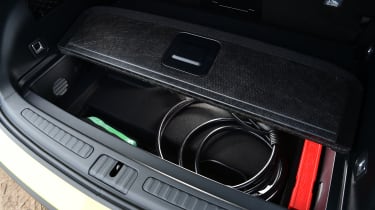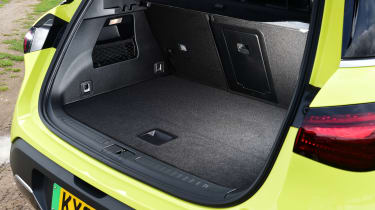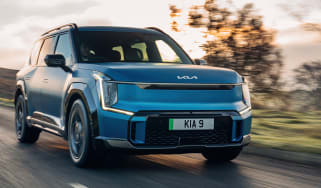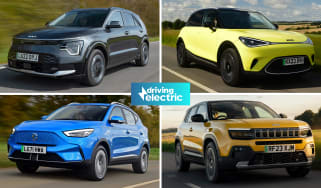Smart #1 review
Rather fittingly, the #1 is a smart-looking and luxurious-feeling small electric SUV with a punchy powertrain, but several flaws keep it from the top of the class
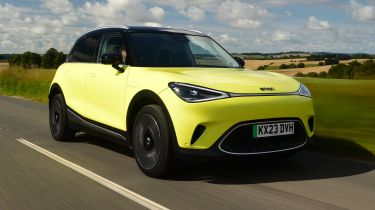
Pros
- Plush interior
- Surprisingly practical
- Range and rapid charging
Cons
- Poor infotainment
- Fidgety ride
- Unpredictable regenerative braking
|
Car type |
Range |
Wallbox charge time |
Rapid charge time |
|
Electric |
248-273 miles |
12hrs 45mins (0-100%, 7.4kW) |
29mins (10-80%, 135kW) |
Smart #1 verdict
On paper, the Smart #1 is an attractive, well-priced small electric crossover that offers a strong electric range. However, despite Smart’s association with premium brand Mercedes-Benz, the execution of its first SUV feels a bit rushed and sloppy. A clunky infotainment system paired with a fidgety suspension setup makes the production #1 feel a bit like a prototype model. This is a shame as the Smart’s posh-feeling interior and powerful electric motor would otherwise make it a tempting proposition.
Range details, specs and alternatives
Smart – maker of dinky city runabouts – has been around since the late 1990s, but now it’s on the verge of a revival under the co-ownership of Mercedes parent Daimler and Chinese automotive group Geely, which also owns Lotus and Polestar. And the all-new Smart #1 is the lynchpin in this brand’s rebirth, and the first of a new generation of electric Smart cars.
Before you ask, yes, you’re supposed to call Smart’s first SUV the “Hashtag one”, not just the Smart one. The ‘#’ symbol will be Smart’s naming convention for its next generation of electric cars – much like Volkswagen’s ‘ID’ or Mercedes’ ‘EQ’ families. The Smart #1 also measures just under 4.3 metres long and 1.6 metres tall, so it’s more crossover than SUV, but in terms of its size it's right in between the Hyundai Kona Electric and Kia Niro EV. Other rivals include the Renault Megane E-TECH Electric and Jeep Avenger.
Underneath the two-tone body and rounded surfacing is Geely’s new EV-dedicated SEA platform, which stands for Sustainable Experience Architecture. It’ll eventually underpin some smaller electric Volvos, including the recently-announced baby EX30 SUV.
The Smart #1 is available in both regular and high-performance Brabus form. Even the former is no slouch; powered by a 268bhp rear-mounted electric motor, it will reach 62mph in a nippy 6.7 seconds. The even more potent Brabus version gets an extra electric motor on the front axle in order to provide four-wheel-drive and boost output to 422bhp. The sprint from 0-62mph takes just 3.9 seconds.
Both feature a 66kWh battery (62kWh of which is usable). Smart says the regular Smart #1 can cover up to 273 miles on a single charge, depending on the exact specification, or 248 miles for the Brabus-tuned version. Both figures are less than the Kia Niro EV’s official range, but the regular Smart #1 can still go further than even facelifted versions of the Vauxhall Mokka Electric or Peugeot e-2008.
The Smart #1 does lead the class when it comes to rapid charging speeds, though; plug the #1 into a suitably fast rapid charger and the car can top up at 150kW, meaning a top up from 10-80% will take less than 30 minutes.
The entry-level Smart #1 Pro+ starts from around £36,000 and manages to undercut its main rivals from Kia and Renault, despite its pitch as a premium product. This competitive pricing doesn’t come at the expense of a strong equipment list, with even base cars getting 19-inch alloy wheels, LED headlights, a 12.8-inch central touchscreen, heated seats, a powered bootlid and a 360-degree camera system.

For an extra £3,000, the Premium model adds Matrix LED headlights, a Beats sound system, leather seats, a head-up display, a heat pump and a 22kW on-board charger. The Launch Edition model starts from just shy of £40,000. It builds on the Premium model with a host of model-specific design flourishes and is limited to just 100 units in the UK (1,000 worldwide).
Finally, there’s the hot Brabus model which, starting from around £43,500 can almost be considered a bargain given the enormous amount of power on offer. This comes fully-loaded with equipment and gets a more aggressive bodykit as well as sporty Alcantara upholstery.
Range, battery size and charging
|
Model |
Range |
Wallbox charge time |
Rapid charge time |
|
#1 |
273 miles |
12hrs 45mins (0-100%, 7.4kW) |
29mins (10-80%, 135kW) |
|
#1 Brabus |
248 miles |
12hrs 45mins (0-100%, 7.4kW) |
29mins (10-80%, 135kW) |
As mentioned, all Smart #1s come equipped with a 62kWh (usable) battery pack, which offers a range of up to 273 miles on the regular model and 248 miles for the #1 Brabus. During our time with the standard Smart #1, we managed to return around 3.8 miles/kWh, which works out to around 236 miles of range – a chunk less than Smart’s quoted figure, but not bad nonetheless.
All models come outfitted with 150kW ultra-rapid charging capability which means a 10-80% charge can take as little as 29 minutes when plugged into a compatible public charger.
Alternatively, if you use a wallbox or public charging point capable of 22kW AC charging, the same will take less than three hours. Fully replenishing the battery from a regular 7.4kW home wallbox requires over 10 hours.
Running costs & insurance
The Smart #1 may be cheaper than many of its direct competitors, but starting at around £36,000, the compact electric SUV isn’t exactly inexpensive to buy outright. Thankfully for company car buyers, the #1’s fully-electric powertrain slots it into the lowest 2% Benefit-in-Kind tax bracket, meaning rock-bottom company car tax payments.
There’s some other benefits to owning an EV like the Smart #1 which can also be taken advantage of by private buyers, too. All EVs are exempt from road tax (VED) until 2025, while they can also pass through London Congestion Charge and Ultra-Low Emissions (ULEZ) zones without incurring a fee, too.
While it’s cheap to buy and run in most respects, the Smart #1 will cost you a little more to insure than rivals – likely due to its potent powertrain. Pro+ and Premium models sit in groups 30 and 31 respectively, while the top-of-the-range Brabus model sits in the relatively high group 39 which still means that it’ll cost less to cover than even a base Tesla Model Y.
Performance, motor & drive
|
Model |
0-62mph |
Top speed | Driven wheels |
Power |
|---|---|---|---|---|
|
#1 |
6.7s |
112mph | Rear |
268bhp |
|
#1 Brabus |
3.9s |
112mph | Four |
422bhp |
The Smart #1 uses a single electric motor to power the rear wheels, which produces 268bhp and 343Nm of torque, and is enough to fling the #1 from 0-62mph in 6.7 seconds. That’s already faster than the quickest versions of the VW ID.3 or Cupra Born can sprint to 62mph, but the even more potent, dual-motor Brabus version pumps out 422bhp for a sub-four-second 0-62mph time – on par with the new MG4 XPower hot hatchback.
Around town is where the Smart #1 feels most at home. The suspension is incredibly soft which means most bumps are absorbed; however, this can also mean that the car can begin to fidget around on the roughest of surfaces.
Things don’t really improve when you get out onto some twisty back roads, either. The car leans a lot in the turns and the eco-spec tyres which help improve range conversely have a negative effect on the amount of grip on offer.
Power delivery is quiet and smooth in all models, but the Brabus turns things up to another level – especially when you select the Sport or Brabus drive modes that give you the full 422bhp to play with. Do this and the two electric motors deliver the 543Nm of torque instantly, like a sledgehammer, sending you all too quickly towards the car’s 112mph top speed.
However, even with stiffer suspension, the #1’s rather limp chassis setup means the Brabus sits as nothing more than a point-and-squirt toy that’s great for impressing people with straight-line performance, rather than taking on B-roads like a hot hatch.
Here, we also thought we’d mention how frustrated we became with the Smart’s regenerative braking system during our test drive. No matter which setting you put it in, there always seems to be a small delay between the power cutting off and any sort of deceleration happening, then even with the softest setting, the car slows more quickly than expected making smooth driving difficult. Regenerative braking is a key feature of EVs as it not only makes driving easier, but it helps recoup some energy and give you a little more range – the #1’s setup feels in need of recalibration and is one of the most inconsistent we’ve used in recent memory.
Interior, dashboard & infotainment
The Smart #1’s interior is perhaps its biggest selling point as it’s where the brand’s connection to Mercedes-Benz is most evident. The overall design is minimalist and classy, while items such as the gear selector stalk, window switches and centre console have almost been directly pulled straight out of a more-expensive Merc. Therefore, the #1 feels much more premium than many of its rivals, with the standard-fit glass roof flooding the cabin with light.
All cars come with a 12.9-inch touchscreen perched atop the dash, alongside a slim digital instrument cluster behind the steering wheel – top spec examples also get a projected head-up display. The touchscreen itself looks impressive and even comes programmed with a virtual assistant in the form of a fox. It can be difficult to navigate, though, with a lot of clutter and different elements not always logically laid out. The fox itself sits in the corner as a good analogy for the #1 as a whole: he’s a nice idea but the animation is jerky and needs a bit of refinement.
Thankfully, while European-spec cars don’t come with any kind of smartphone connectivity, the UK model we drove is equipped as standard with both Apple CarPlay and Android Auto, allowing you to escape the clutches of the glitchy fox for a more seamless infotainment experience.
Boot space, seating & practicality
|
Length |
Width |
Height | Boot volume (seats up/down) |
|---|---|---|---|
|
4,270mm |
1,822mm |
1,636mm | 411/976 litres |
In stark contrast to the tiny, two-seater Smart fortwo that the brand is probably best known for, you have enough space for four adults in the #1. There’s plenty of headroom, too – even with the panoramic roof. There are several cubbyholes scattered around the cabin, although we find the centre console lid to be a tad flimsy, something that’s compounded by the fact you have to lean your elbow on it while operating the touchscreen.
Open up the bonnet via a catch in the footwell and you’ll find a small 15-litre storage cubby that’s ideal for storing your charging cables. The rear hatch hides 323 litres of boot space in Pro+ models, or 313 litres for models carrying the Beats subwoofer. However, you can push the rear seats forward by 13cm and expand that capacity up to 411 litres, according to Smart. The square shape makes it easy to load items, although a Kia Niro EV will still be able to carry more luggage.
Reliability & safety rating
Reliability data for the Smart #1 is virtually non-existent yet due to how new it is. Things aren’t helped by the fact that it sits on an all-new platform, making it difficult to get any idea on how dependable the new electric SUV might be.
What we do know, however, is that the Smart #1 was recently awarded a full five-star safety rating from Euro NCAP – something that may come as a surprise to many, given how the fortwo could only muster a four-star rating back in 2014 when the tests were much more lenient.
All Smart #1s come loaded with safety and driver assistance kit including a fatigue-detection camera, autonomous emergency braking (AEB), adaptive cruise control and automatic high beams. As mentioned, there’s also a standard-fit 360-degree camera system for reference during tight manoeuvres.

